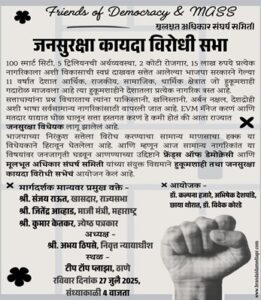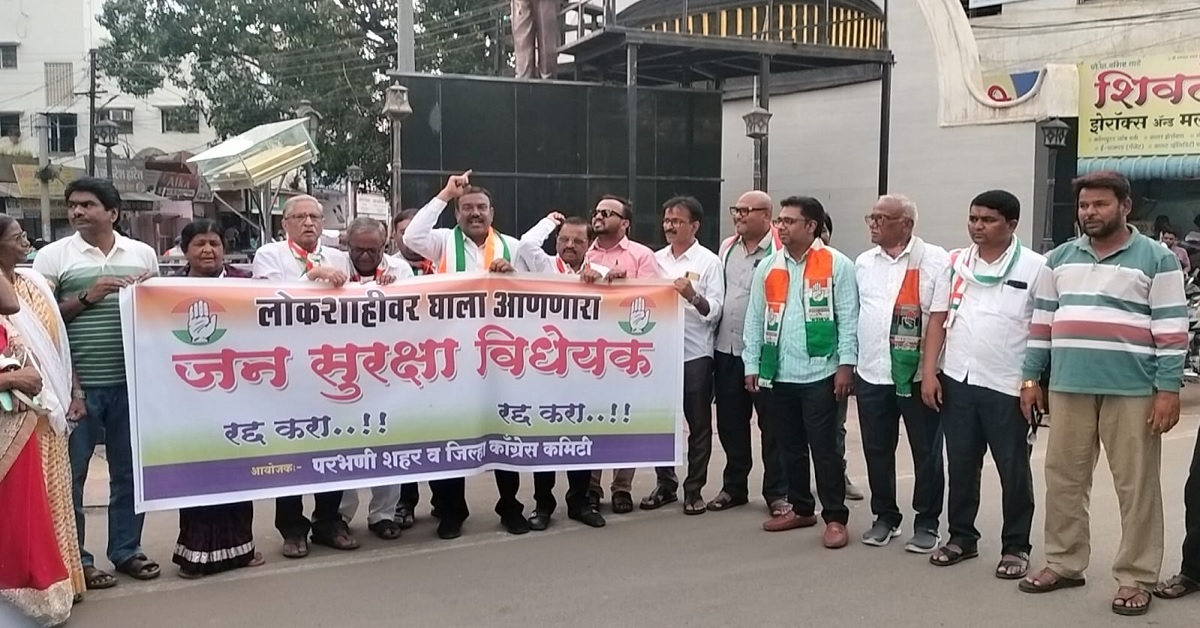In July 2025, the state of Maharashtra became the stage for a remarkable wave of protests. Across cities and districts, three powerful resistance movements have emerged—each sparked by different state actions, but each unified in their rejection of increasing authoritarianism, social marginalisation, and legalised dispossession.
- In Thane, Parbhani, and Kolhapur, opposition parties, including the Maharashtra Congress, and civil rights groups are rallying against the newly passed Maharashtra Public Safety Act (MSPS)—a sweeping law that criminalises democratic dissent.
जनसुरक्षा कायद्याला कडाडून विरोध करण्यासाठी कोल्हापूर जिल्हाध्यक्ष श्री.सतेजजी पाटील यांच्या उपस्थितीत आज कोल्हापूर जिल्हा व शहर काँग्रेसच्या वतीने काँग्रेसच्या कार्यालयाबाहेर जनसुरक्षा कायद्याची होळी करून संविधानिक मार्गाने काम करणाऱ्या विरोधी पक्ष संघटना, शिव- शाहू- फुले-… pic.twitter.com/Z8hz5JEODR
— Maharashtra Congress (@INCMaharashtra) July 21, 2025
परभणी जिल्हा व शहर काँग्रेसच्यावतीने परभणीतील डॉ. बाबासाहेब आंबेडकर यांच्या पुतळ्याजवळ जनसुरक्षा कायद्याला कडाडून विरोध करण्यासाठी संविधानिक मार्गाने काम करणाऱ्या विरोधी पक्ष संघटना, शिव- शाहू- फुले- आंबेडकरवादी संघटना, पुरोगामी, शेतकरी कामगार संघटना यांना संपवणाऱ्या आणि… pic.twitter.com/AG6GSGSzjT
— Maharashtra Congress (@INCMaharashtra) July 21, 2025
- In Chhatrapati Sambhaji Nagar and Nanded, members of the Qureshi Muslim community have initiated a state-wide boycott of the cattle trade in protest against a decade of mob lynching, police harassment, and what they call a campaign of “economic strangulation.”
- And on the shores of Sassoon Dock in Mumbai, the Koli fishing community is resisting sudden evictions despite years of assurances, demanding protection of their ancestral rights and the right to the sea.
Together, these protests tell a larger story: of how state power, legal instruments, and vigilante violence are reshaping the rights, identities, and futures of working-class and marginalised communities across Maharashtra.
- The Public Safety Act: A law to silence the people
When the Maharashtra Special Public Security (MSPS) Bill, 2024 was passed by the Maharashtra legislature in June 2025, the government claimed it was a necessary measure to combat “urban Naxalism” and protect public order. But opposition parties, constitutional scholars, and over 12,500 citizens who submitted objections to the Joint Select Committee saw the law for what it is: a legal instrument to suppress protest, stifle opposition, and criminalise constitutional expression.
The law allows the state to declare any activity or organisation “unlawful” if it is seen to disturb “public order” or interfere with “established institutions.” But these terms are undefined, vague, and dangerously expansive. Jan Suraksha Vidheyak Virodhi Sangharsh Samiti approached the Governor of Maharashtra on July 16, 2025 and submitted a memorandum against the said Bill.
The memorandum stated that “The Sangharsh Samiti has strongly opposed the Jan Suraksha Bill (Bill No. XXXIII of 2024), as the Bill is a direct assault on the democratic and fundamental rights of the citizens of the State. We believe that in the name of curbing Naxalism, due to its vague formulation, the Act is likely to be misused against common citizens, social activists and organisations who legitimately raise their voice against unjust government policies and actions. The stifling of any form of opposition and dissent, is antithetical to the democratic frame of our Constitution. A more detailed note outlining our major objections to the Bill, is attached herewith.”
The additional memorandum submitted to the Governor on July 22, 2025 highlighting that Section 2(f), which defines unlawful activity argued that the state definition is so wide it could criminalise rasta rokos, satyagrahas, pamphleteering, or even social media posts.
The additional memorandum to the Governor provided that “The definition of “unlawful activity” is too broad and all-encompassing. While the Chief Minister has repeatedly stated that morchas, andolans, and other democratic forms of protest will not be disallowed, the fact is that the definition of “unlawful activity” as defined in Sec 2 (f) of the Act is so broad that morchas, andolans etc. fall squarely within the said definition. It is necessary that the assurances in this regard as given on the floor of the House, must be translated into black and white on paper.”
Under Section 5, the Advisory Board, originally meant to serve as a constitutional check, has also been structurally weakened. Under amendments introduced by the Joint Select Committee, the Board may now include retired district judges and government advocates, compromising its independence.
Opposition erupted state-wide:
- In Parbhani, Congress leaders gathered at the Ambedkar statue to burn copies of the Bill and denounce it as an attack on Ambedkarite and Phule-Shahu ideals.
- In Kolhapur, 2,000 people blocked a police contingent and set fire to symbolic effigies of the law, calling it “black inside and out.”
- In Thane, a major public meeting on July 27 brought together journalist Kumar Ketkar, Rajya Sabha MP Sanjay Raut, former minister Jitendra Awhad, and retired judge Abhay Thipse, all calling for the repeal of the Act.
As reported by The Week, Congress state president Harshvardhan Sapkal, in a widely covered press conference at Gandhi Bhavan, alleged that the law was designed not to curb extremism but to protect industrialists grabbing land in Dharavi, or extracting mineral wealth from Surjagad in Gadchiroli.
“This law is draconian inside and out and is meant to suppress the common people… The only beneficiaries will be the government and the industrialists who support it — the ones who have grabbed land in Dharavi, looted mineral resources in Surjagad (Gadchiroli), and want red-carpet access to the Shaktipeeth highway corridor.”
The Governor is yet to grant assent, and civil society groups continue to demand that the Bill be returned to the Assembly under Article 200 of the Constitution. More such protests are planned in Maharashtra. On July 27, 2025 there is a protest meeting in Thane that will be addressed among others by former judge, Abhay Thipsay.

- The Qureshi Community’s economic boycott against mob violence
On July 1, 2025, a quiet revolution began in Chhatrapati Sambhaji Nagar. Members of the Qureshi Muslim community, who are traditionally involved in buffalo meat and cattle trade, announced they were ceasing all commercial activity indefinitely.
The reason? A decade of mob lynchings, extortion, and police collusion under the pretext of gau Raksha (cow protection). Haji Aslam Sultan Qureshi, president of the Maharashtra Jamat ul Quresh, spoke with Hindustan Times and stated that “We are legal traders, but gau rakshaks beat us, loot our vehicles, and often kill with impunity. Even when we transport buffaloes, which are legal, they attack us. And the police help them.”
The community cites multiple fatal cases:
- Rafeeq Tamboli, beaten to death in 2021;
- Affan Ansari, killed in 2024;
- Seven deaths in Washim district alone, the report provided, as per local community leader Nabi Qureshi.
Over time, slaughterhouses in many districts have been shut down or denied veterinary certification, making legal slaughter impossible. As per a report of The Wire, in Nanded, there are no functioning taluka-level veterinary officers. As a result, butchers are forced to slaughter in homes, illegal under the law, making them further vulnerable to FIRs and raids. “We are being pushed into illegality by design,” said a butcher from Parbhani, according to The Wire report, “then arrested for surviving.”
On July 15, the HT report provided, a Qureshi delegation met Minister of State for Home Yogesh Kadam and DGP Rashmi Shukla, demanding a written assurance of protection. Kadam refused, offering only oral promises.
Meanwhile, according to the report of The Wire, the government’s official position hardened. On July 14, Minister Pankaj Bhoyar announced:
- A new law to combat beef smuggling;
- Withdrawal of all cases against gau rakshaks;
- Possible invocation of the Maharashtra Control of Organised Crime Act (MCOCA) against cattle transporters.
The report of The Wire provides that activists like Juned Atar have documented how vigilante groups coordinate across districts, sending tip-offs when cattle transport begins and ambushing vehicles with police support. “The state is now weaponising bureaucracy against us,” said Kaizer Patel, AIMIM lawyer, who estimates that ₹300 crore worth of trade has been halted state-wide. “The real victims are the poor—Qureshis, farmers, drivers, meat vendors, and even the hotel industry.”
- Sassoon Dock Standoff and the Fight for Coastal Rights
The third protest front opened in Mumbai—on the land and waters of Sassoon Dock, a historic fishing port that sustains tens of thousands of Koli fisherfolk, warehouse operators, ice vendors, and boatmen.
On July 23, a team from the Mumbai Port Authority (MbPA) arrived with police support to evict godown operators on the basis of a 2014 Supreme Court ruling. The MbPA claims the godown operators are unauthorised sub-lessees and that the original leaseholder is the Maharashtra Fisheries Development Corporation (MFDC).
But, as reported by Hindustan Times, the Koli community sees this eviction as a betrayal of past assurances. In a 2015 ministerial meeting at Vidhan Bhavan, Nitin Gadkari and Eknath Khadse had assured that:
- Ready Reckoner rent rates would not apply, and
- No eviction would be carried out without consultation.
“If MbPA claims otherwise, they should give us that in writing,” said Krishna Pawle, president of Shiv Bharatiya Port Sena, reported Hindustan Times.
“Today they’re coming for the warehouses. Tomorrow, they’ll come for our boats,” warned Bhaskar Tandel, former chair of the Machimaar Sarvoday Society, while speaking with HT, “We have been here longer than the Port Authority itself.”
The eviction was stalled by a mass protest of over 2,000 people, and Koli leaders have warned that 20,000 will occupy Sassoon Dock if the eviction continues after the seasonal fishing ban ends on August 1.
For the Koli community, this is about more than tenancy. It is about ancestral claims, survival, and identity in a rapidly gentrifying Mumbai.
Conclusion: Criminalisation as policy, resistance as survival
In all three protests, a clear pattern emerges:
- Legal frameworks—whether the MSPS Act, cow protection laws, or tenancy regulations—are being used to delegitimise, displace, or detain.
- Marginalised communities—Muslims, Tribals, Bahujans, and traditional coastal dwellers—are increasingly forced into protest just to survive.
- And when they protest, they are labelled as Naxals, smugglers, or encroachers.
These protests are not merely political reactions. They are defences of constitutional existence, carried out in courtrooms, streets, markets, docks, and under statues of Ambedkar and Shivaji. In Maharashtra today, protest is not dissent. It is self-defence.
Related:
Azad Maidan erupts in protest as Maharashtra set to enact sweeping law aimed at silencing dissent
TN: Sugarcane Farmers Protest, Demand Better FRP, Reintroduction of SAP
From Sindhudurg to Mumbai, Maharashtra erupts in protest against repressive public safety bill

